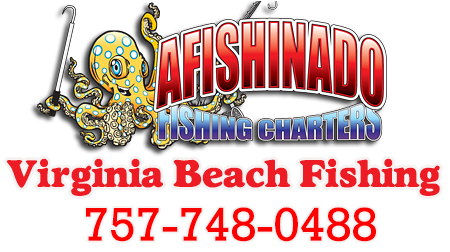AfishinadoVB Sportfishing Charters targets all these popular fish species of the Chesapeake Bay. When you make the trip to Virginia Beach for your fishing vacation you will certainly have a chance at catching one or more of these pictured species. So check out the fish, book your charter fishing trip with a Virginia Beach Fishing Charter, and get ready to hook up with one of these magnificent species of the Bay on your next fishing adventure.
Listed below are some of the more common species we catch in the Chesapeake Bay region.

COBIA
OTHER NAMES: Ling, Crab Eater, Lemonfish, Bacalao
RANGE: All Florida coasts; widespread throughout the Bahamas and Caribbean, although seldom plentiful.
HABITAT: All the way from shallow inshore waters to the deep sea. Most Florida Cobia winter in the southern reaches of the state of offshore, migrating northward in the Spring to cover both coasts. Dramatic runs occur along Panhandle beaches in April. Cobia love to hang around navigation markers, wrecks and artificial reefs, where they swim both at the surface and down deep. They also escort wandering Mantas and other large rays, and many are caught around those hosts. Juveniles are frequently caught incidentally by trout fishermen over many Gulf Coast grass flats-and same big ones too.
DESCRIPTION: In the water, Cobia look very much like sharks. The usual color is brown or dark gray above, whitish on the underside, with a dark stripe running from gills to base of tail. The striped appearance is more vivid in juveniles. Several rather sharp finlets on the dorsal surface extend from behind the head to the dorsal fin.
SIZE: Common from 20 to 50 pounds; sometimes up to 80 pounds, and possibly to 100 or more. World record 135 pounds, 9 ounces; Florida record 114 pounds, 8 ounces.
FOOD VALUE: Excellent, smoked or fresh.
GAME QUALITIES: A strong but unpredictable fighter. Usually clicks off fairly long, fast runs, and can fight deep with great stamina; however, many individuals put on lackluster fights if not pressured too hard saving their best efforts for after they are boasted!
TACKLE AND BAITS: Surf tackle is the best bet for pier fishing and for boat fishing when long casts with heavy lures are called for. Since Cobia are notorious for wrapping lines around buoys and wreck structure, most anglers use 30-pound-test line or heavier. Once clear of obstructions, however, even large Cobia can be successfully fought with spinning, baitcasting and fly tackle although a minimum of 10-pound line or tippet is advisable. When gaffed "green" (not tired), Cobia can-and often do smash up the inside of a boat. Jigs and large streamer flies are the most-used artificials. Spoons and swimming plugs often work well; you might wake them up with a surface plug, popper or tube lure. Live baitfish, such as Pinfish, Mullet, Cigar Minnows, Grunts and Jacks work best, but live shrimp, crabs, dead fish or squid are good too.

Spot - May to November - Spot usually appear in all areas of the Chesapeake Bay in the late spring and will hang around in the surf, bays and inlets until fall when the water starts to cool around late October or early November at which time they will make a run to warmer deeper water for the winter.
SIZE: Averages 6-8 inches; Sometimes will grow to over a pound..
FOOD VALUE: One of the most popular panfish.
GAME QUALITIES: Spirited panfish. Great fishing fun for the kids and family.
TACKLE AND BAITS: Light spinning tackle, small hooks, blooworms, fishbites, pieces of cut fish, squid or shrimp.
FISHING STYLE: Bottom fishing, either drifting or anchored.
MORE INFORMATION: Caught bottom fishing with bait, anchored or drifting from boats, also caught from docks, piers, shore and surf; big runs of fish in the fall in lower Chesapeake Bay and in surf and piers of Virginia Beach.
Caught throughout the entire Chesapeake Bay and Bay tributary rivers, coastal ocean waters, inlets - all inshore Maryland and Virginia coastal waters
June - October; peak July - September for Chesapeake Bay and tributary rivers; peak middle August - middle October in lower Bay and coastal ocean areas.
8 - 12 ounces
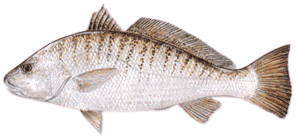
Croaker - May to November - Croaker usually run hand in hand or fin and fin that is with spot. Usually if you are catching croaker you will most like catch spot too. Croaker usually appear in all areas of the Chesapeake Bay in the late spring and will hang around in the surf, bays and inlets until fall when the water starts to cool around October at which time the bite will slow down.
SIZE: Averages a pound or less, but sometimes reache super sizes of 3 pounds or more.
FOOD VALUE: Croaker make good panfish.
GAME QUALITIES: Very scrappy fighter. A large croaker can be a real fun fight.
TACKLE AND BAITS: A blast to catch on light tackle. Can be caught on bloodworms, squid strips, cutbait, and even a small jig.
FISHING STYLE: Drifting, anchored, bottom fishing.
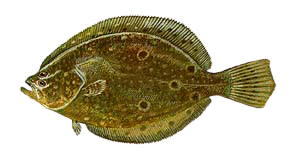
Flounder - April to November - Flounder aka fluke enter the Chesapeake Bay around late April to early May. Flounder are usually daytime feeders and tend to hit squid or stripped cut bait. If you are looking to catch a trophy sized flounder, over 5 or 6 pounds you may want tp try live bait like a small spot or small croaker above.
SIZE: Averages around a pound or two but can reach sizes over 15 pounds.
FOOD VALUE: Excellent table fare, common on many restuarant menus.
GAME QUALITIES: Very scrappy fighter. A very distinct fighting action and experienced flounder anglers can usually tell right away if they have a flounder on the line as soon as the fight starts.
TACKLE AND BAITS: Fun to catch but you must be patient. Give them the bait a bit before you yank back on the rod. Use squid strips or cut bait strips on a small lightweight bucktail. Can be caught trolling on the bottom around structure..
FISHING STYLE: Drifting, trolling. Can be caught on the edges of boat or shipping channels or around rocks or bridge pilings.
Trout - May to November - Gray trout, also called weakfish and summer trout become active in the Chesapeake Bay around the month of May and will not leave until as late as November. They range from pan size to larger than 10 pound.
SIZE: Averages around a pound or two for bottom fishers but can reach sizes over 15 pounds, especially for wire liners or live baiters.
FOOD VALUE: Very good, larger trout can be fileted.
GAME QUALITIES: Not really a brawler but the larger trout can put up a decent fight straight down. Care must be taken when fighting and landing gray trout because they have a very soft mouth.
TACKLE AND BAITS: Wide range of baits can be used for gray trout. Squid, peeler crabs, shrimp, live spot or other live bait, artificial lures.
FISHING STYLE: Drifting or anchored up for the smaller gray trout, trolling along structure for large gray trout.
Other Summer Species of the Chesapeake Bay
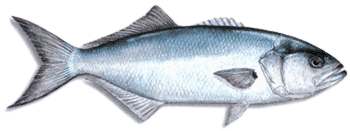
Bluefish
Speckled Trout
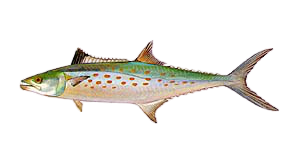
Spanish Mackerel

